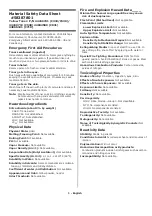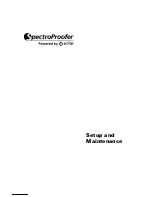
Stay ahead. With Agfa Global Services.
:Anapurna M
4F
- Operator Manual
Information - Safety instructions
7
The sensors must always be activitated
when the engine is powered on!
!
In order to reset the Anapurna M4F you have to press the enter button. This will cause
a system restart where the shuttle raises to its highest point and returns to its home
position.
When the safety sensor is activated, the
print will be canceled and the actual job
cannot be restored. You have to re-spool
the file by choosing print in the Wasatch
print queue.
Agfa strongly advises against disabling the
safety sensor since this increases the risk
of getting your hands or other body parts
caught between the moving parts of the
engine. So, you should always make sure
that the sensors are activated
The safety sensors can be disabled by go-
ing into offline mode (press escape) and by
pressing CLEANING / IP SET (F4). The F2
function will now show the SAFETY SEN-
SOR funtion and by hitting F2, you can use
the up button to toggle the value on or off
and press enter.
1.4
U.V. light.
Working with U.V. light, you must keep following safety warning in mind:
Avoid direct skin contact
Wear protective glasses when looking in the direction of the U.V. light.
The U.V. radiation that is generated when the U.V. lamps are on, can be harmful. Make
sure that no body parts are directly exposed to the radiation. Skin burn and irritation
will be the consequence when e.g. your hands have direct contact with the radiation.
Don’t look directly into the U.V. light, this will damage your eye sight. If you need to
look in the direction of the U.V. light, make sure that you wear protective glasses.
a. Detail of the UV light
UV lamps emit not only ultraviolet light, but also visible light, and wavelengths in
the infrared spectrum.
In fact, all lamps emit approximately
20% ultraviolet light (the part that creates curing is not visible; cold light);
20% visible light (the inactive part that we see coming out of the lamphouses);
60% infrared light (also an inactive part that is invisible and generates heat).
Short wavelength UV light exhibits more quantum properties than its visible and
infrared counterparts. Ultraviolet light is arbitrarily broken down into three bands,
according to its anecdotal effects.
UV-A is the least harmful and most commonly found type of UV light, because
it has the least energy. UV-A light is often called black light. Most phototherapy
and tanning booths use UV-A lamps.
UV-B is typically the most destructive form of UV light, because it has enough
energy to damage biological tissues, yet not quite enough to be completely ab-
sorbed by the atmosphere. UV-B is known to cause skin cancer.
Short wavelength UV-C is almost completely absorbed in air within a few hun-
dred meters. When UV-C photons collide with oxygen atoms, the energy ex-
change causes the formation of ozone. Germicidal UV-C lamps are often used to
purify air and water, because of their ability to kill bacteria.








































